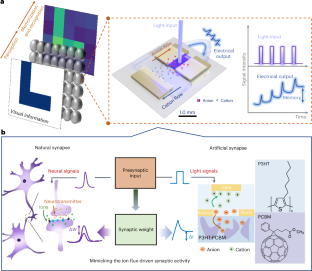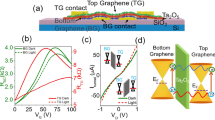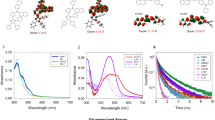Abstract
Optoelectronic synapses can perceive and memorize visual information, making them appealing for future bionic eyes or vision automation. Organic field-effect transistors are a promising platform for optoelectronic synaptic devices thanks to their flexibility and biocompatibility. However, charge screening effects occurring at channel–dielectric interfaces hinder the implementation of programmable multilevel memories. Here, we report photonic organic synapses based on photon-modulated electrochemical doping in electrochemical transistors, where light can manipulate ion insertion into the photoactive layer composed of donor–acceptor heterojunction interfaces. This enables high-density multilevel conductance modulation at low operating voltages (<1 V) and the imitation of ion flux-driven synaptic activity of living systems. The devices can recognize different optical signals and mimic the learning processes of the human brain. By exploiting the integrated functions of perception, processing and memorization of visual information, a single-layer synapse array acts as an artificial retina enabling facial recognition without the use of a complex artificial neural network.
This is a preview of subscription content, access via your institution
Access options
Access Nature and 54 other Nature Portfolio journals
Get Nature+, our best-value online-access subscription
$29.99 / 30 days
cancel any time
Subscribe to this journal
Receive 12 print issues and online access
$209.00 per year
only $17.42 per issue
Buy this article
- Purchase on Springer Link
- Instant access to full article PDF
Prices may be subject to local taxes which are calculated during checkout






Similar content being viewed by others
Data availability
The data that support the findings of this study are available from the Purdue University Research Repository at https://purr.purdue.edu/publications/4245/1.
Code availability
The code that supports the face recognition and fashion product classification within this paper is available from the corresponding author upon a reasonable request.
References
Jung, Y. H., Park, B., Kim, J. U. & Kim, T. Bioinspired electronics for artificial sensory systems. Adv. Mater. 31, 1803637 (2019).
Woods, G. A., Rommelfanger, N. J. & Hong, G. Bioinspired materials for in vivo bioelectronic neural interfaces. Matter 3, 1087–1113 (2020).
Kim, Y. et al. A bioinspired flexible organic artificial afferent nerve. Science 360, 998–1003 (2018).
Shim, H. et al. Artificial neuromorphic cognitive skins based on distributed biaxially stretchable elastomeric synaptic transistors. Proc. Natl Acad. Sci. USA 119, e2204852119 (2022).
Yang, X. et al. Bioinspired neuron-like electronics. Nat. Mater. 18, 510–517 (2019).
van de Burgt, Y. et al. A non-volatile organic electrochemical device as a low-voltage artificial synapse for neuromorphic computing. Nat. Mater. 16, 414–418 (2017).
Shao, L., Zhao, Y. & Liu, Y. Organic synaptic transistors: the evolutionary path from memory cells to the application of artificial neural networks. Adv. Funct. Mater. 31, 2101951 (2021).
Lee, W. W. et al. A neuro-inspired artificial peripheral nervous system for scalable electronic skins. Sci. Robot. 4, eaax2198 (2019).
Li, P., Anwar Ali, H. P., Cheng, W., Yang, J. & Tee, B. C. K. Bioinspired prosthetic interfaces. Adv. Mater. Technol. 5, 1900856 (2020).
Juzekaeva, E. et al. Coupling cortical neurons through electronic memristive synapse. Adv. Mater. Technol. 4, 1800350 (2019).
Heng, W., Solomon, S. & Gao, W. Flexible electronics and devices as human–machine interfaces for medical robotics. Adv. Mater. 34, 2107902 (2022).
Chortos, A., Liu, J. & Bao, Z. Pursuing prosthetic electronic skin. Nat. Mater. 15, 937–950 (2016).
Someya, T., Bao, Z. & Malliaras, G. G. The rise of plastic bioelectronics. Nature 540, 379–385 (2016).
Spyropoulos, G. D., Gelinas, J. N. & Khodagholy, D. Internal ion-gated organic electrochemical transistor: a building block for integrated bioelectronics. Sci. Adv. 5, eaau7378 (2019).
Jastrzebska-Perfect, P. et al. Mixed-conducting particulate composites for soft electronics. Sci. Adv. 6, eaaz6767 (2020).
Khodagholy, D. et al. Organic electronics for high-resolution electrocorticography of the human brain. Sci. Adv. 2, e1601027 (2016).
Zhang, J., Dai, S., Zhao, Y., Zhang, J. & Huang, J. Recent progress in photonic synapses for neuromorphic systems. Adv. Intell. Syst. 2, 1900136 (2020).
Girtan, M. Is photonics the new electronics? Mater. Today 17, 100–101 (2014).
Hong, S. et al. Neuromorphic active pixel image sensor array for visual memory. ACS Nano 15, 15362–15370 (2021).
Zhou, F. et al. Optoelectronic resistive random access memory for neuromorphic vision sensors. Nat. Nanotechnol. 14, 776–782 (2019).
Ham, S., Choi, S., Cho, H., Na, S.-I. & Wang, G. Photonic organolead halide perovskite artificial synapse capable of accelerated learning at low power inspired by dopamine-facilitated synaptic activity. Adv. Funct. Mater. 29, 1806646 (2019).
Lv, Z. et al. Mimicking neuroplasticity in a hybrid biopolymer transistor by dual modes modulation. Adv. Funct. Mater. 29, 1902374 (2019).
Wang, H. et al. A ferroelectric/electrochemical modulated organic synapse for ultraflexible, artificial visual-perception system. Adv. Mater. 30, 1803961 (2018).
Wang, S. et al. A MoS 2 /PTCDA hybrid heterojunction synapse with efficient photoelectric dual modulation and versatility. Adv. Mater. 31, 1806227 (2019).
Dai, S. et al. Light-stimulated synaptic devices utilizing interfacial effect of organic field-effect transistors. ACS Appl. Mater. Interfaces 10, 21472–21480 (2018).
Wang, K. et al. Light‐stimulated synaptic transistors fabricated by a facile solution process based on inorganic perovskite quantum dots and organic semiconductors. Small 15, 1900010 (2019).
Qian, C. et al. Solar-stimulated optoelectronic synapse based on organic heterojunction with linearly potentiated synaptic weight for neuromorphic computing. Nano Energy 66, 104095 (2019).
Zhang, Q. et al. Organic field effect transistor‐based photonic synapses: materials, devices, and applications. Adv. Funct. Mater. 31, 2106151 (2021).
Deng, Z. et al. Recent progresses of organic photonic synaptic transistors. Flex. Print. Electron. 7, 024002 (2022).
Gong, X. et al. High-detectivity polymer photodetectors with spectral response from 300 nm to 1450 nm. Science 325, 1665–1667 (2009).
Yang, X. et al. Nanoscale morphology of high-performance polymer solar cells. Nano Lett. 5, 579–583 (2005).
Zucker, R. S. & Regehr, W. G. Short-term synaptic plasticity. Annu. Rev. Physiol. 64, 355–405 (2002).
Yang, J. et al. Photo-induced ultrafast active ion transport through graphene oxide membranes. Nat. Commun. 10, 1171 (2019).
Xiao, K. et al. Artificial light-driven ion pump for photoelectric energy conversion. Nat. Commun. 10, 74 (2019).
Guo, J., Ohkita, H., Benten, H. & Ito, S. Near-IR femtosecond transient absorption spectroscopy of ultrafast polaron and triplet exciton formation in polythiophene films with different regioregularities. J. Am. Chem. Soc. 131, 16869–16880 (2009).
Guo, J., Ohkita, H., Benten, H. & Ito, S. Charge generation and recombination dynamics in poly(3-hexylthiophene)/fullerene blend films with different regioregularities and morphologies. J. Am. Chem. Soc. 132, 6154–6164 (2010).
Samaria, F. S. & Harter, A. C. Parameterisation of a stochastic model for human face identification. In Proc. IEEE Workshop Appl. Comput. Vis. 138–142 (IEEE, 1994).
Acknowledgements
This work is supported by Ambilight Inc under contract no. 4000187.02 (K.C., J.M., I.S., W.L., A.A). Work at the University of Texas at San Antonio was supported by the Welch Foundation through the Welch Chair under grant no. AX-0045-20110629 (H.G., K.S). H.H. contributed to simulation for facial and object recognition with no funding support. In addition, the authors are grateful to L. Pan and Q. Qian for their valuable contributions and insights in photolithography printing.
Author information
Authors and Affiliations
Contributions
K.C. and J.M. conceived the idea and designed the experiments. K.C. performed the experiments and characterization. H.H. performed simulation for facial and object recognition. I.S. performed microelectrode patterning. H.G. and K.S. performed transient spectroscopy measurements. W.L. and A.A. provided comments during the experiments and revision. K.C. and J.M. drafted the manuscript and all authors contributed towards writing the paper.
Corresponding author
Ethics declarations
Competing interests
J.M. is a cofounder of Ambilight Inc., which sponsors this work. A patent disclosure was filed by Purdue University. The remaining authors declare no competing interests.
Peer review
Peer review information
Nature Photonics thanks the anonymous reviewers for their contribution to the peer review of this work.
Additional information
Publisher’s note Springer Nature remains neutral with regard to jurisdictional claims in published maps and institutional affiliations.
Supplementary information
Supplementary Information
Supplementary Discussion, Figs. 1–31, Tables 1 and 2 and References.
Supplementary Video
Device response to hand wave in ambient lighting condition.
Rights and permissions
Springer Nature or its licensor (e.g. a society or other partner) holds exclusive rights to this article under a publishing agreement with the author(s) or other rightsholder(s); author self-archiving of the accepted manuscript version of this article is solely governed by the terms of such publishing agreement and applicable law.
About this article
Cite this article
Chen, K., Hu, H., Song, I. et al. Organic optoelectronic synapse based on photon-modulated electrochemical doping. Nat. Photon. 17, 629–637 (2023). https://doi.org/10.1038/s41566-023-01232-x
Received:
Accepted:
Published:
Issue Date:
DOI: https://doi.org/10.1038/s41566-023-01232-x
This article is cited by
-
Strain-insensitive viscoelastic perovskite film for intrinsically stretchable neuromorphic vision-adaptive transistors
Nature Communications (2024)
-
Organic mixed conductors for bioinspired electronics
Nature Reviews Materials (2023)



